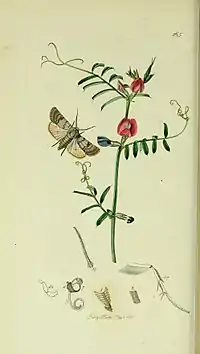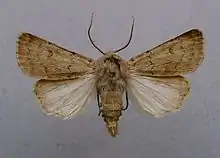Agrotis cinerea
Agrotis cinerea, the light feathered rustic, is a moth of the family Noctuidae. The species was first described by Michael Denis and Ignaz Schiffermüller in 1775. It is found in southern and central Europe, northern Turkey, the Caucasus, western Turkmenia and central Asia.

| Agrotis cinerea | |
|---|---|
 | |
| Scientific classification | |
| Kingdom: | Animalia |
| Phylum: | Arthropoda |
| Class: | Insecta |
| Order: | Lepidoptera |
| Superfamily: | Noctuoidea |
| Family: | Noctuidae |
| Genus: | Agrotis |
| Species: | A. cinerea |
| Binomial name | |
| Agrotis cinerea (Denis & Schiffermüller, 1775) | |
| Synonyms | |
| |
The wingspan is 33–40 mm. Forewing ashy grey, with darker irroration (sprinkling): claviform and orbicular stigmata obsolete: reniform a small dark lunule; a distinct diffuse dark median shade: hindwing whitish, in the female grey-tinged. — in the ab. alpigena Tur. the wings are paler and the markings indistinct, while in ab. livonica Teich they are very much darker. — ab. fusca Bsd., is larger than the typical form, and black brown; — subsp. tephrina Stgr. is smaller, with forewing narrower, and the markings much clearer; this form is confined to the south of England. Tutt, writing in 1892, Brit. Noct. 11, p. 76, evidently with only British specimens before him, did not notice that the British race was per se distinct from continental forms, so that the aberrations which he there put forward must be considered as applying solely to the British race: — these are ab. pallida Tutt, pale grey without median shade and all males; — ab. obscura Tutt nec Hbn. a unicolorous dull brown form generally (but not always) confined to females; and ab. virgata Tutt pale grey with a distinct reddish median shade, and all males.[1]
Adults are on wing from May to June depending on the location and are active during both day and night and can be found near flowers, such as Berberis vulgaris
The larvae feed on the roots and leaves of low-growing herbaceous plants and grasses, including Thymus praecox, Stellaria media, Medicago sativa, Rumex and Taraxacum. .[2]
References
- Seitz, A. Ed., 1914 Die Großschmetterlinge der Erde, Verlag Alfred Kernen, Stuttgart Band 3: Abt. 1, Die Großschmetterlinge des palaearktischen Faunengebietes, Die palaearktischen eulenartigen Nachtfalter, 1914
- "Robinson, G. S., P. R. Ackery, I. J. Kitching, G. W. Beccaloni & L. M. Hernández, 2010. HOSTS - A Database of the World's Lepidopteran Hostplants. Natural History Museum, London".
Further reading
- South R. (1907) The Moths of the British Isles, (First Series), Frederick Warne & Co. Ltd., London & NY: 359 pp. online Britain and Ireland
External links
| Wikimedia Commons has media related to Agrotis cinerea. |
- Light Feathered Rustic at UKMoths
- Savela, Markku. "Agrotis cinerea (Denis & Schiffermüller, 1775)". Lepidoptera and Some Other Life Forms. Retrieved June 27, 2019.
- Lepiforum e.V.